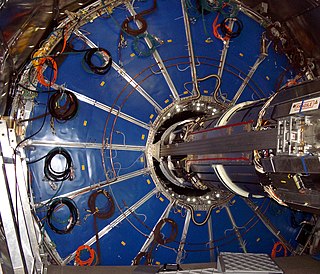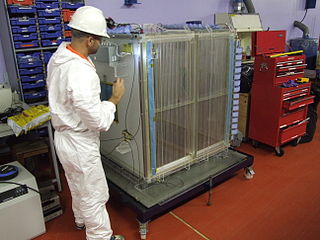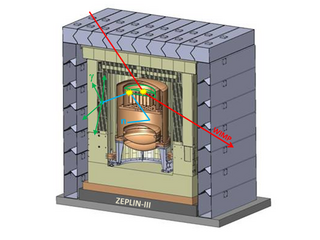Weakly interacting massive particles (WIMPs) are hypothetical particles that are one of the proposed candidates for dark matter.

In physics, a time projection chamber (TPC) is a type of particle detector that uses a combination of electric fields and magnetic fields together with a sensitive volume of gas or liquid to perform a three-dimensional reconstruction of a particle trajectory or interaction.
The Cryogenic Dark Matter Search (CDMS) is a series of experiments designed to directly detect particle dark matter in the form of Weakly Interacting Massive Particles. Using an array of semiconductor detectors at millikelvin temperatures, CDMS has at times set the most sensitive limits on the interactions of WIMP dark matter with terrestrial materials. The first experiment, CDMS I, was run in a tunnel under the Stanford University campus. It was followed by CDMS II experiment in the Soudan Mine. The most recent experiment, SuperCDMS, was located deep underground in the Soudan Mine in northern Minnesota and collected data from 2011 through 2015. The series of experiments continues with SuperCDMS SNOLAB, an experiment located at the SNOLAB facility near Sudbury, Ontario in Canada that started construction in 2018 and is expected to start data taking in early 2020s.
The XENON dark matter research project, operated at the Italian Gran Sasso National Laboratory, is a deep underground detector facility featuring increasingly ambitious experiments aiming to detect hypothetical dark matter particles. The experiments aim to detect particles in the form of weakly interacting massive particles (WIMPs) by looking for rare nuclear recoil interactions in a liquid xenon target chamber. The current detector consists of a dual phase time projection chamber (TPC).
T2K is a particle physics experiment studying the oscillations of the accelerator neutrinos. The experiment is conducted in Japan by the international cooperation of about 500 physicists and engineers with over 60 research institutions from several countries from Europe, Asia and North America and it is a recognized CERN experiment (RE13). T2K collected data within its first phase of operation from 2010 till 2021. The second phase of data taking (T2K-II) is expected to start in 2023 and last until commencement of the successor of T2K – the Hyper-Kamiokande experiment in 2027.
The ArDM Experiment was a particle physics experiment based on a liquid argon detector, aiming at measuring signals from WIMPs, which may constitute the Dark Matter in the universe. Elastic scattering of WIMPs from argon nuclei is measurable by observing free electrons from ionization and photons from scintillation, which are produced by the recoiling nucleus interacting with neighbouring atoms. The ionization and scintillation signals can be measured with dedicated readout techniques, which constituted a fundamental part of the detector.
PICO is an experiment searching for direct evidence of dark matter using a bubble chamber of chlorofluorocarbon (Freon) as the active mass. It is located at SNOLAB in Canada.

DEAP is a direct dark matter search experiment which uses liquid argon as a target material. DEAP utilizes background discrimination based on the characteristic scintillation pulse-shape of argon. A first-generation detector (DEAP-1) with a 7 kg target mass was operated at Queen's University to test the performance of pulse-shape discrimination at low recoil energies in liquid argon. DEAP-1 was then moved to SNOLAB, 2 km below Earth's surface, in October 2007 and collected data into 2011.

The MicroMegas detector is a gaseous particle detector coming from the development of the wire chamber. Invented in 1992 by Georges Charpak and Ioannis Giomataris, the Micromegas detectors are mainly used in experimental physics, in particular in particle physics, nuclear physics and astrophysics for the detection of ionising particles.

The Large Underground Xenon experiment (LUX) aimed to directly detect weakly interacting massive particle (WIMP) dark matter interactions with ordinary matter on Earth. Despite the wealth of (gravitational) evidence supporting the existence of non-baryonic dark matter in the Universe, dark matter particles in our galaxy have never been directly detected in an experiment. LUX utilized a 370 kg liquid xenon detection mass in a time-projection chamber (TPC) to identify individual particle interactions, searching for faint dark matter interactions with unprecedented sensitivity.

The Directional Recoil Identification from Tracks (DRIFT) detector is a low pressure negative ion time projection chamber (NITPC) designed to detect weakly interacting massive particles (WIMPs) - a prime dark matter candidate.
Light dark matter, in astronomy and cosmology, are dark matter weakly interacting massive particles (WIMPS) candidates with masses less than 1 GeV. These particles are heavier than warm dark matter and hot dark matter, but are lighter than the traditional forms of cold dark matter, such as Massive Compact Halo Objects (MACHOs). The Lee-Weinberg bound limits the mass of the favored dark matter candidate, WIMPs, that interact via the weak interaction to GeV. This bound arises as follows. The lower the mass of WIMPs is, the lower the annihilation cross section, which is of the order , where m is the WIMP mass and M the mass of the Z-boson. This means that low mass WIMPs, which would be abundantly produced in the early universe, freeze out much earlier and thus at a higher temperature, than higher mass WIMPs. This leads to a higher relic WIMP density. If the mass is lower than GeV the WIMP relic density would overclose the universe.

The European Underground Rare Event Calorimeter Array (EURECA) is a planned dark matter search experiment using cryogenic detectors and an absorber mass of up to 1 tonne. The project will be built in the Modane Underground Laboratory and will bring together researchers working on the CRESST and EDELWEISS experiments.

EDELWEISS is a dark matter search experiment located at the Modane Underground Laboratory in France. The experiment uses cryogenic detectors, measuring both the phonon and ionization signals produced by particle interactions in germanium crystals. This technique allows nuclear recoils events to be distinguished from electron recoil events.
The DarkSide collaboration is an international affiliation of universities and labs seeking to directly detect dark matter in the form of weakly interacting massive particles (WIMPs). The collaboration is planning, building and operating a series of liquid argon time projection chambers (TPCs) that are employed at the Gran Sasso National Laboratory in Assergi, Italy. The detectors are filled with liquid argon from underground sources in order to exclude the radioactive isotope 39
Ar, which makes up one in every 1015 (quadrillion) atoms in atmospheric argon. The Darkside-10 (DS-10) prototype was tested in 2012, and the Darkside-50 (DS-50) experiment has been operating since 2013. Darkside-20k (DS-20k) with 20 tonnes of liquid argon is being planned as of 2019.

The ZEPLIN-III dark matter experiment attempted to detect galactic WIMPs using a 12 kg liquid xenon target. It operated from 2006 to 2011 at the Boulby Underground Laboratory in Loftus, North Yorkshire. This was the last in a series of xenon-based experiments in the ZEPLIN programme pursued originally by the UK Dark Matter Collaboration (UKDMC). The ZEPLIN-III project was led by Imperial College London and also included the Rutherford Appleton Laboratory and the University of Edinburgh in the UK, as well as LIP-Coimbra in Portugal and ITEP-Moscow in Russia. It ruled out cross-sections for elastic scattering of WIMPs off nucleons above 3.9 × 10−8 pb from the two science runs conducted at Boulby.

Elena Aprile is an Italian-American experimental particle physicist. She has been a professor of physics at Columbia University since 1986. She is the founder and spokesperson of the XENON Dark Matter Experiment. Aprile is well known for her work with noble liquid detectors and for her contributions to particle astrophysics in the search for dark matter.

The LUX-ZEPLIN (LZ) Experiment is a next-generation dark matter direct detection experiment hoping to observe weakly interacting massive particles (WIMP) scatters on nuclei. It was formed in 2012 by combining the LUX and ZEPLIN groups. It is currently a collaboration of 30 institutes in the US, UK, Portugal and South Korea. The experiment is located at the Sanford Underground Research Facility (SURF) in South Dakota, and is managed by the United States Department of Energy's (DOE) Lawrence Berkeley National Lab.

Jocelyn Monroe is an American experimental particle physicist who is a professor at Royal Holloway, University of London. Her research considers the development of novel detectors as part of the search for dark matter. In 2016 she was honoured with the Breakthrough Prize in Fundamental Physics for her work on the Sudbury Neutrino Observatory.
Direct detection of dark matter is the science of attempting to directly measure dark matter collisions in Earth-based experiments. Modern astrophysical measurements, such as from the Cosmic Microwave Background, strongly indicate that 85% of the matter content of the universe is unaccounted for. Although the existence of dark matter is widely believed, what form it takes or its precise properties has never been determined. There are three main avenues of research to detect dark matter: attempts to make dark matter in accelerators, indirect detection of dark matter annihilation, and direct detection of dark matter in terrestrial labs. The founding principle of direct dark matter detection is that since dark matter is known to exist in the local universe, as the Earth, Solar System, and the Milky Way Galaxy carve out a path through the universe they must intercept dark matter, regardless of what form it takes.










